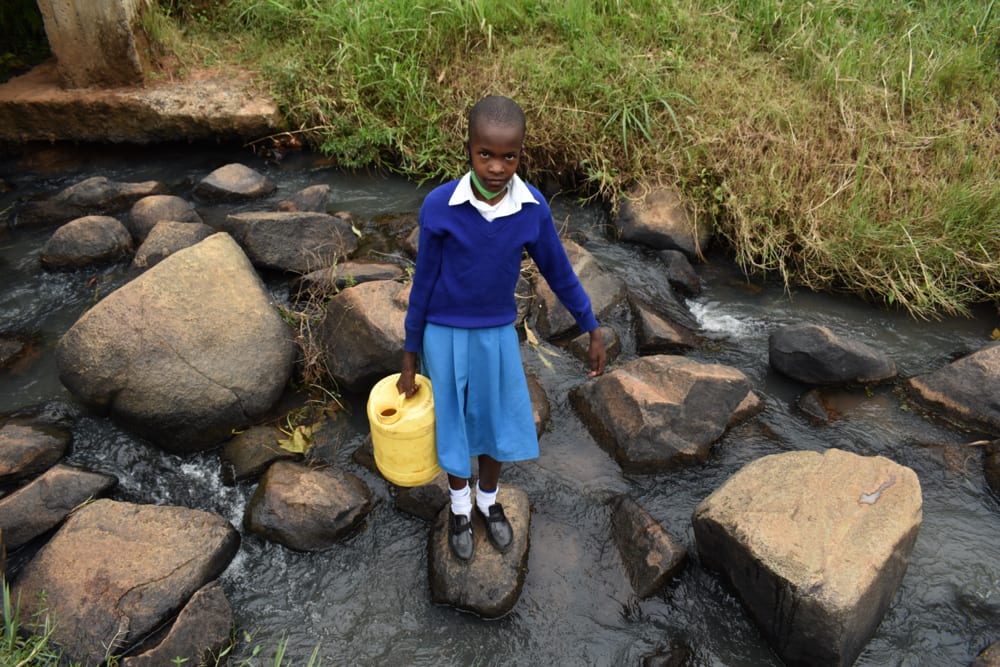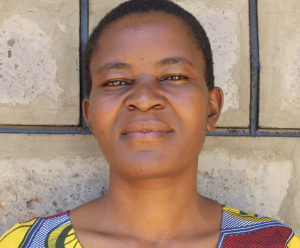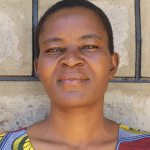In 1982, community members from Mudindi along with the Friends Quaker Church founded Friends Mudindi Village Primary School to help bring education closer to home for the area's pupils. The school is located in the center of the village. Beginning with just 10 pupils, today the school serves 460 students and 15 teachers and staff. But another thing has grown alongside the school's population: their severe water crisis.
For all of these students, there is just one water source on campus: a small plastic rain tank. The tank quickly runs dry due to its size compared to the student population, so there is a daily routine of relying on students to deliver water to the school.
This routine begins each morning when pupils must arrive at school by 6:30 am carrying water from home. But "home" water can come from any number of sources, including a dirty stream beneath an underpass on the road to school. Teachers are unable to track where every student fetches water, so by the time students line their jerrycans up at school, no one can tell the difference between originally safe and unsafe sources.
The school does not have a lunch program at school, so pupils return home for lunch. When they come back to school for their afternoon lessons, they must again come carrying water. Aside from the stream and any water families may have stored at home, some students also use a protected spring in the village. But even safe water from the spring becomes contaminated when it enters' students dirty jerrycans or gets mishandled en route to school.
"I personally cannot drink water from this school because the water is carried in dirty jerrycans from home. I have been sick throughout the school year, and I spend a lot of money on medication. I will still be spending until the solution is solved. Also, absenteeism has been high in this school according to my records, but the cause is water," explained Deputy Headmaster Thomas Asige.
Because water is combined for use at school, even one contaminated source means the entire school is at risk of water-related illnesses. Students repeatedly report cases of diarrhea, vomiting, and typhoid after drinking water at school. These illnesses are expensive to treat and drain pupils' families of their financial resources. Students, meanwhile, miss class while they recover.
"The water situation affects me because mostly I drink water at school, so my parents are always seeking medication and they spend a lot of money. This leads to absenteeism and has affected my learning. I am requesting your help," said student Cheryl.

Time lost to being sick compounds with the time and energy students lose each day on their multiple walks to fetch water for the school. Carrying water and books at the same time is tiring, and a lot of class time ends up being lost to the task. Pupils' academic performance is lagging as a result.
What We Can Do:
Rain Tank
A 75,000-liter rainwater catchment tank will help alleviate the water crisis at this school. The school will help collect the needed construction materials such as sand, bricks, rocks, and water for mixing cement. We will complement their materials by providing an expert team of artisans, tools, hardware, and the guttering system. Once finished, this tank will begin catching rainfall that will be used by the school’s students and staff for drinking, handwashing, cooking, cleaning, and much more.
We and the school strongly believe that all of these components will work together to improve standards at this school, which will help lead to better student academic performance and will help to unlock the potential for these students to live better, healthier lives.
Handwashing Stations
The student health club will oversee the two new handwashing stations we will provide, and make sure they are kept clean and in working condition. The club leaders will fill the handwashing stations with water daily and make sure they are always supplied with a cleaning agent such as soap or ash.
VIP Latrines
Two triple-door latrine blocks will be constructed with local materials that the school will help gather. Three doors will serve the girls and three doors will serve the boys. All of these new latrines will have cement floors that are designed to be easy to use and to clean. And with a rain tank right on school property, there should be enough water to keep them clean.
Training on Health, Hygiene, COVID-19, and More
We will hold a one-day intensive training session with students, teachers, and parents. This training will cover a wide range of topics including COVID-19 symptoms, transmission routes, and prevention; personal and environmental hygiene; and the operation and maintenance of the rain tank, latrines, and handwashing stations. There will be a special emphasis on handwashing.
Our team of facilitators will use a variety of methods to train, including participatory hygiene and sanitation transformation, and asset-based community development. We will initiate a student health club, which will prepare students to lead other pupils into healthy habits at school and at home. We will also lead lectures, group discussions, and provide illustrative handouts to teach health topics and ways to promote good hygiene practices within the school including handwashing and water treatment. We will then conduct a series of follow-up trainings before transitioning to our regularly scheduled support visits throughout the year.

 Rainwater Catchment
Rainwater Catchment
 Rehabilitation Project
Rehabilitation Project








































